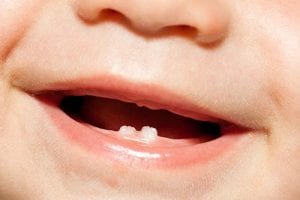Most parents will recognize when their baby begins teething as everything they pick up tends to be put into the mouth. It is not necessary for parents to be dental professionals, but a better understanding of teeth formation will help to take better care or perhaps alleviate some of the discomforts that a baby feels when teething.
Baby Teeth Eruption and Development
There is no fixed schedule for the eruption of baby teeth, as it differs from child to child, much like various other areas of development for each child. Generally, girls’ teeth begin to appear before boys, and they normally start pushing through the gums at about 6 months of age. The bottom two front teeth (central incisors) are the ones that appear first, and they are usually followed by the top four front teeth. Soon after, the other teeth begin to slowly fill in. They normally appear in pairs with one on each side of the jaw, and before you know it, a baby has 10 pairs of teeth, with one set of each pair on the upper and lower jaws.
The progression of when teeth begin to appear and when they disappear to be replaced by permanent teeth is very interesting.
Upper Jaw
When a baby is about 8 to 12 months old, the two top central incisors begin to appear. About a month later, the lateral incisors begin to show. The top front incisors will last until the child is about 6 to 7 years old and will begin to fall out as the permanent teeth develop. About a year later, the lateral incisors will fall out.
At about 13 to 19 months, the first molar begins to appear, and these may last until the child is about 9 to 11 years old.
The canine or cuspids that are used primarily for chewing begin showing at about 16 to 22 months, and begin falling out when the child reaches between 10 and 12 years of age.
The second molar is the last to appear between the ages of 2 to 3 years and will fall out to be replaced by the permanent ones when the child is about 10 to 12 years old.
Lower Jaw
 Parents are usually elated when the first two central incisors appear on the lower jaw, normally when a baby is about 6 to 8 months old. They will last until the child reaches 6 to 7 years of age when the permanent set develops.
Parents are usually elated when the first two central incisors appear on the lower jaw, normally when a baby is about 6 to 8 months old. They will last until the child reaches 6 to 7 years of age when the permanent set develops.
At about 10 to 16 months, the lateral cuspids or canines appear. These last until junior is about 7 or 8 years old.
The first molar appears at about 14 to 18 months, and begin falling out at about when the child is about 9 to 11 years old.
The canine cuspids that control bite appear at about 17 to 23 months and fall out when the child reaches around 10 years old.
The second molar appears last, at about 2 to 3 years and will be replaced by permanent teeth when the child is about 10 to 12 years old.
Knowing when to expect certain teeth to appear can pinpoint phases of your child’s development and can help you prepare for improved ideas associated with the tasks of nutrition.
Caring for Baby’s Teeth
Proper dental hygiene practices should start even before teeth appear. Although they do not last for very long, it is important that care is taken of baby teeth as they play a vital role in a baby’s healthy development.
- The health of baby teeth can affect the health or development of the permanent teeth which follow them.
- The baby teeth are a pre-cursor to the permanent and help to shape a baby’s face.
- Missing or decayed teeth can cause discomfort and lead to poor nutrition as a baby may find it difficult to eat certain foods.
Baby Teeth and Child Development
While baby teeth are developing, there are important changes happening that shape your child. Speech patterns are developing as well as the facial structure, so is important to pay close attention. Some other things that you may note are that the primary teeth will be smaller in size and whiter than the permanent teeth that follow. By the time the child reaches 3 years old, all the primary teeth should have appeared, and between the ages of 6 and 12 years old, there is likely to be a mixture of primary and permanent teeth in the mouth.
The Importance of Proper Oral Hygiene
 The importance of proper oral hygiene cannot be overstressed even at an early age with the primary teeth. Damage or decay of primary teeth can lead to serious issues in future adult teeth. Tooth decay in toddlers can be painful and may lead to other serious issues such as gum and enamel damage or other difficulties with permanent teeth.
The importance of proper oral hygiene cannot be overstressed even at an early age with the primary teeth. Damage or decay of primary teeth can lead to serious issues in future adult teeth. Tooth decay in toddlers can be painful and may lead to other serious issues such as gum and enamel damage or other difficulties with permanent teeth.


